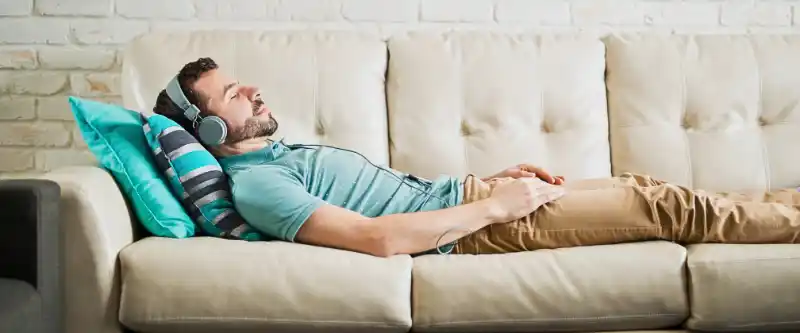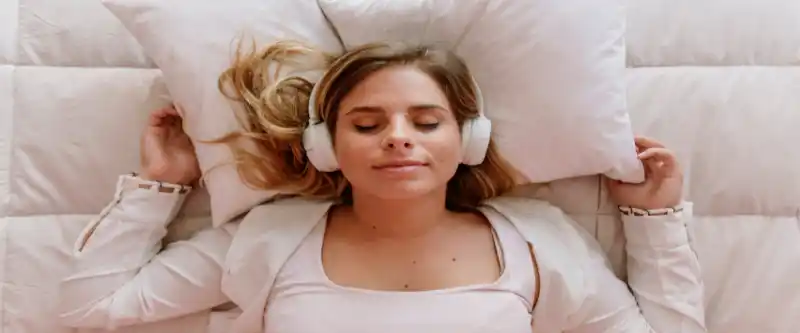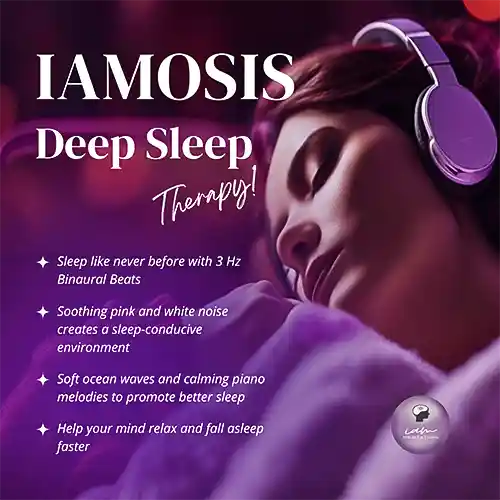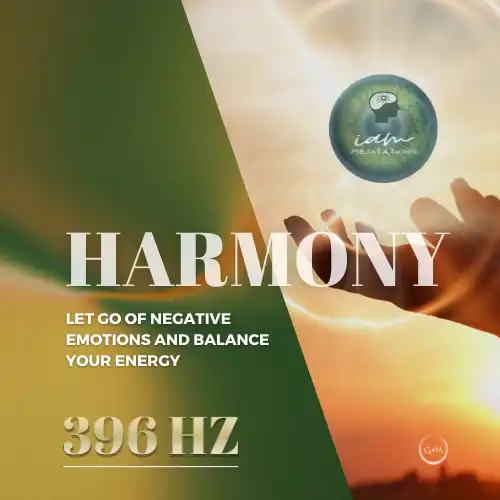The Powerful Benefits of Deep
Sleep Music
What is Deep Sleep music and what it can do
Learn How to use deep Sleep music. How to listen to deep sleep music. How can deep sleep music help you.
67% of adults don’t get enough sleep
Deep Sleep Music - A Natural Solution
How do you feel when you wake up in the morning? Do you feel refreshed and energized, ready to face the day? Or do you feel groggy and tired, wishing you could go back to bed?
We’ve all experienced those nights where we toss and turn for what feels like hours, unable to fall asleep no matter how tired we feel. Perhaps stressful thoughts swirl around in our heads and prevent relaxation. Or our bodies simply feel too energized to unwind.
According to a survey by Philips, 67% of adults worldwide say they don’t get enough sleep. And that’s a problem, because lack of sleep can have serious consequences for our health and well-being.
Whatever the reason for your sleep troubles, deep sleep music could provide the soothing solution you’ve been looking for. Developed specifically to induce relaxation and aid the sleep process, deep sleep music employs elements of binaural beats, isochronic tones, and sleep-inducing melodies and rhythms to lull your mind and body into a peaceful slumber.
In this comprehensive guide, we’ll explore exactly what deep sleep music is, how it works its relaxing magic, and the proven benefits supported by scientific research. We’ll also recommend a brand-new track designed to maximize deep sleep.
By the end, we are confident you’ll understand why countless people struggling with insomnia, anxiety, or restlessness have turned to deep sleep music as a natural sleep aid.

A full comprehensive guide on what is deep sleep music, what it can do and how it can help you
Table of Contents
Naturally wake up feeling refreshed
What is Deep Sleep Music?
Put simply, deep sleep music is a genre of music purposefully created to induce deep, restorative sleep through calming sounds and brainwave-entraining frequencies. Deep sleep music aims to facilitate the deepest stages of non-REM sleep through carefully crafted audio stimulation.
Tracks are usually an hour or more in length to accompany you throughout all sleep stages until you naturally wake up feeling refreshed.
Deep sleep is the most restorative stage of sleep, where your body repairs itself and your brain consolidates memories. It typically occurs in the first half of the night, and lasts for about 20% of your total sleep time.
However, many factors can interfere with your ability to enter and maintain deep sleep, such as stress, noise, light, temperature, caffeine, alcohol, medications, and aging. That’s why deep sleep music can be a useful tool to enhance your sleep quality and quantity.
Leading producers like I AM Meditations build clinically-backed methodologies into each track to shift brainwaves down into relaxing theta and delta wave patterns conducive to deep restorative slumber.
Our Deep Sleep Music track is a mesmerizing blend of 3 Hz binaural beats, soothing pink noise, and enchanting dreamy piano melodies. It is designed to transport you to a realm of deep relaxation and restorative sleep.
The Key Elements
Some key elements that make up deep sleep music include:
➣ Binaural Beats: Binaural beats are an auditory illusion that occurs when two slightly different frequencies are played into each ear through stereo headphones. Your brain processes these tones and perceives the difference between them as a beat, even though no external beat is present. Studies show binaural beats can synchronize brainwaves to specific frequencies associated with different states of consciousness, like deep sleep.
Our comprehensive guide on Binaural Beats For Deeper Meditation is your roadmap to understanding the science and benefits behind this powerful tool. Explore the intricacies of binaural beats and learn how they influence brainwave activity, induce relaxation, and enhance your meditation practice.
➣ Isochronic Tones: Rather than using different frequencies in each ear like binaural beats, isochronic tones present the same frequency tones repeatedly to both ears simultaneously. The off-and-on pulses still enable brainwave entrainment.
➣ Relaxing Melodies: Gentle, slow-tempo melodies provide a soothing backdrop. Instruments like piano, harp, flute, and nature sounds like rainstorms are often used to create a tranquil atmosphere.
➣ Slow Tempos: Deep sleep music maintains a very slow tempo between 60–80 beats per minute to mimic relaxation response in the body and slow brainwaves during sleep stages.
➣ Long Durations: Tracks last 60 minutes or longer to accompany you through all sleep cycles until natural morning awakening.
The unique combination of embedded brainwave entrainment stimuli plus relaxing melodies and tempos work synergistically to shift the mind and body into a deeply calm and sleepy state, ideal for falling asleep quickly and enjoying restorative slumber.
If you are wondering how does deep sleep music work, keep reading. What is deep sleep music? What are the benefits of listening to deep sleep music? Find out in this article.
Brainwave entrainment and relaxation
How Does Deep Sleep Music Work?

Deep sleep music produces its somnific effects through brainwave entrainment and relaxation of both mind and body. Binaural beats and isochronic tones guide neural synchronization to frequencies associated with deep sleep stages. In parallel, slow melodies, nature sounds and tempos trigger your innate relaxation response.
This decreases stress hormone cortisol along with mental and physical tension. A calm mind-body state allows much faster onset of refreshing rest. Entrainment to circadian brainwave rhythms may further optimize the sleep-wake cycle overall. The synergistic influence of embedded sounds gently but powerfully induces the deepest, most restorative sleep possible.
Entrainment is the process of synchronizing your brainwaves with an external stimulus. For example, if you listen to a sound that has a frequency of 10 Hz (cycles per second), your brain will tend to produce brainwaves that match that frequency. This can influence your state of consciousness and mood.
Entrainment can be used to induce different stages of sleep by using different frequencies. For example, delta waves are the slowest brainwaves (0.5-4 Hz) and are associated with deep sleep. Theta waves are slightly faster (4-8 Hz) and are associated with light sleep and dreaming. Alpha waves are even faster (8-12 Hz) and are associated with relaxation and meditation.
By listening to sounds that have these frequencies embedded in them, you can stimulate your brain to produce the corresponding brainwaves. This can help you transition from wakefulness to sleepiness, and from light sleep to deep sleep.
Do you want to experience a harmonious blend of 3 Hz binaural beats, and soul-stirring solfeggio frequencies, including 528 Hz and 417 Hz? Our Happiness Meditation Music resonates with your heart and solar plexus chakras, promoting healing, balance, and deep relaxation.
The science
Let’s take a closer look at the science behind how deep sleep music induces sleep and benefits the brain and body:
➣ Brainwave Entrainment: Binaural beats and isochronic tones aim specific frequencies at brainwave patterns associated with deep sleep stages. Your brain naturally synchronizes to these embedded stimuli, shifting neural activity into deeper sleep brainwave patterns like delta and theta waves.
➣ Relaxation Response: The slow melodies, nature-like sounds, and tempos below 60 BPM trigger your body’s innate relaxation response initiated by the parasympathetic nervous system. This counteracts stress responses and activates rest-and-digest physiology.
➣ Decreased Cortisol: Lowered stress levels lead to reduced levels of cortisol, the stress hormone known to interfere with sleep when circulating at abnormal times like before bed. With cortisol lowered, you feel more sleepy and your body better prepares for rest.
➣ Calmed Mind: Not only does deep sleep music soothe the body, but the lack of abrupt changes, lyrics, or complex arrangements calms a restless mental chatter that can disrupt sleep onset. A tranquil mind promotes quicker sleep.
➣ Entrainment to Circadian Rhythms: Certain frequencies in deep sleep music may also help synchronize circadian brainwaves to the body’s natural 24-hour sleep-wake cycle, improving nighttime sleepiness and morning wakefulness.
Simply put, the embedded auditory stimuli combine mind and body relaxation with neural synchronization, directly targeting better sleep quality at a physiological level. Deep sleep becomes essentially effortless when guided by music’s relaxing influence on brain and biology.
Masking
Masking is the process of covering up unwanted sounds with more pleasant ones. For example, if you live in a noisy city, you might use white noise or nature sounds to drown out the traffic or sirens outside your window. This can help you fall asleep faster and reduce the chances of being disturbed by sudden noises during the night.
Masking can also help you create a consistent and relaxing sleep environment. By listening to the same sounds every night before bed, you can train your brain to associate them with sleep. This can make it easier for you to fall asleep and stay asleep.
The Powerful Benefits of Deep Sleep Music
Benefits of Listening to Deep Sleep Music

With an understanding of how deep sleep music works its magic, let’s explore the key benefits research has found it provides:
➣ Promotes Faster Sleep Onset: Studies show listening to deep sleep music before bed reduces time taken to fall asleep compared to silence. Music helps relax the mind and body into a sleepy state quicker.
➣ Enhances Sleep Quality & Duration: Not only do people fall asleep faster, but overall sleep architecture improves. Participants report longer and less disrupted sleep when using deep sleep music. Deep sleep music can help you stay asleep longer, and wake up less often during the night. This can increase the amount of time you spend in deep sleep, which is essential for your physical and mental recovery.
➣ Reduced Insomnia Symptoms: For those suffering from chronic insomnia, deep sleep music has demonstrated effectiveness at reducing classic insomnia complaints like difficulty falling asleep, frequent awakenings, early morning wakening and overall poor sleep quality.
➣ Decreased Daytime Sleepiness: With better nightly slumber, deep sleep music listeners experience less daytime fatigue, sleepiness, irritability, and brain fog compared to baseline. Energy levels improve.
➣ Lowered Stress & Anxiety: Cortisol-lowering effects and relaxation of both the mind and body from deep sleep music lead to noticeable reductions in perceived stress, tension, worry, and anxiety – all enemies of healthy sleep.
➣ Better Mood Regulation: Ample research connects poor sleep to worsening of depression and low mood. Deep sleep music, by optimizing sleep, indirectly lifts and stabilizes mood and emotions the following day. It can help you wake up feeling refreshed and energized, ready to face the day. You will also experience less mood swings and irritability, and more happiness and positivity.
➣ Increased Focus & Productivity: With reduced daytime sleepiness and improved mood, deep sleep music allows people to feel more focused, motivated and productive in their daytime activities without cognitive fatigue getting in the way.
➣ Provides Gentler Alternative to Sleep Aids: For those who want to avoid pharmaceutical sleep drugs and their potential side effects, deep sleep music offers a natural, drug-free option for better quality shuteye.
As you can see, deep sleep music’s evidence-backed benefits span all areas of healthy sleep, stress relief, mood and even increased cognition and performance when adequately rested. No wonder more individuals are turning to this simple yet powerful relaxation tool each night.
To learn more about therapeutic music and the benefits of using it, we strongly encourage you to explore the mystical world of solfeggio frequencies. Our comprehensive guide on What Are Solfeggio Frequencies is your gateway to unraveling the secrets of these ancient tones. Learn how these frequencies resonate with your energy centers, promote balance, and facilitate healing on a deep level.
Experience the deep relaxation and inner peace that 963 Hz frequency can bring. Perfect for meditation, yoga, and spiritual growth.
396 Hz Solfeggio Frequency can revitalize your energy and help you break negative emotions. Experience its Healing Power with our 396 Hz track.
Enhance your sleep
How to Incorporate Deep Sleep Music

Now that we understand what deep sleep music is and all it can do to enhance your sleep, let’s discuss best practices for incorporating it into your bedtime routine:
➣ Choose Genres Tailored to Your Needs: While most deep sleep music has universal relaxing properties, certain genres may better suit your needs for falling asleep faster versus staying asleep. Be open-minded in finding what works best.
➣ Pre-Sleep Listening is Optimal: For best results in synchronizing your brainwave patterns and relaxing your body fully, listen to deep sleep music beginning 30 minutes before your desired bedtime while getting comfortable.
➣ Wear Headphones for Strongest Entrainment: Play music directly into your ears via stereo headphones to maximize brainwave synchronization from binaural beats and isochronic tones. Speakers just aren’t as effective.
➣ Set Long, Uninterrupted Playlists: Opt for hour-plus long tracks or autoplaying playlists to accompany you all the way through sleep cycles until morning. Avoid getting up to restart music.
➣ Keep Devices out of Bed: The blue light and stimulation from phones/tablets can paradoxically energize rather than relax you. Only use headphones and keep devices on a bedside table in airplane mode.
➣ Remove Stressors from your Bedroom: Create a dark, cool, quiet space free of work, TV and stimulating activities to reinforce your bedroom as a calm oasis dedicated solely to restful slumber.
➣ Be Patient with Positive Effects: Like with any lifestyle change, give deep sleep music 2–4 weeks of consistent use to take full effect. Sleep is a complex process and benefits take time to noticeably emerge. Stick with it!
By thoughtfully incorporating high-quality deep sleep music in a manner consistent with best practices, you set yourself up for reaping maximum soothing rewards on both your sleep quality and stress levels over the long run. The investment is well worth it.
To further enhance your experience, we recommend reading our article on how to use Morning Meditation Music. Discover how it can infuse your day with tranquility and focus, as we guide you through the benefits of incorporating meditation music into your morning routine.
Improve the quality of your life
Conclusion
Incorporating deep sleep music into your nightly schedule is a simple yet profoundly impactful way to optimize your brainwaves, boost deep sleep and reap wide-ranging health rewards.
Developing optimal sleep hygiene sets you up for success. With regular practice, deep sleep music is a natural self-care strategy that could significantly improve quality of life.
So, why settle for restless nights when you can embrace the power of deep sleep music?
Revolutionary Healing Frequencies are a unique system of healing tones used in meditation music to correct imbalances in the body.
A positive mindset is a powerful force that can shape our lives and bring forth incredible transformations. It is a state of mind where optimism, hope, and resilience thrive.
Don’t miss out on our latest insights, tips, and resources for living a happier, healthier life.
Subscribe to our blog and receive regular doses of motivation, inspiration, and practical advice straight to your inbox!






